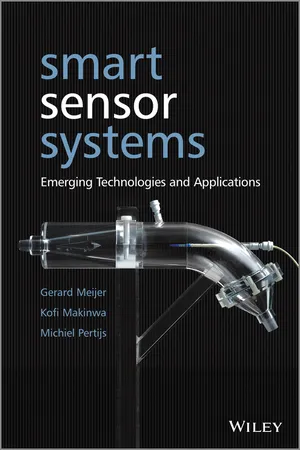
Smart Sensor Systems
Emerging Technologies and Applications
- English
- ePUB (mobile friendly)
- Available on iOS & Android
Smart Sensor Systems
Emerging Technologies and Applications
About this book
With contributions from an internationally-renowned group of experts, this book uses a multidisciplinary approach to review recent developments in the field of smart sensor systems, covering important system and design aspects. It examines topics over the whole range of sensor technology from the theory and constraints of basic elements, physics and electronics, up to the level of application-orientated issues.
Developed as a complementary volume to 'Smart Sensor Systems' (Wiley 2008), which introduces the basics of smart sensor systems, this volume focuses on emerging sensing technologies and applications, including:
- State-of-the-art techniques for designing smart sensors and smart sensor systems, including measurement techniques at system level, such as dynamic error correction, calibration, self-calibration and trimming.
- Circuit design for sensor systems, such as the design of precision instrumentation amplifiers.
- Impedance sensors, and the associated measurement techniques and electronics, that measure electrical characteristics to derive physical and biomedical parameters, such as blood viscosity or growth of micro-organisms.
- Complete sensor systems-on-a-chip, such as CMOS optical imagers and microarrays for DNA detection, and the associated circuit and micro-fabrication techniques.
- Vibratory gyroscopes and the associated electronics, employing mechanical and electrical signal amplification to enable low-power angular-rate sensing.
- Implantable smart sensors for neural interfacing in bio-medical applications.
- Smart combinations of energy harvesters and energy-storage devices for autonomous wireless sensors.
Smart Sensor Systems: Emerging Technologies and Applications will greatly benefit final-year undergraduate and postgraduate students in the areas of electrical, mechanical and chemical engineering, and physics. Professional engineers and researchers in the microelectronics industry, including microsystem developers, will also find this a thorough and useful volume.
Frequently asked questions
- Essential is ideal for learners and professionals who enjoy exploring a wide range of subjects. Access the Essential Library with 800,000+ trusted titles and best-sellers across business, personal growth, and the humanities. Includes unlimited reading time and Standard Read Aloud voice.
- Complete: Perfect for advanced learners and researchers needing full, unrestricted access. Unlock 1.4M+ books across hundreds of subjects, including academic and specialized titles. The Complete Plan also includes advanced features like Premium Read Aloud and Research Assistant.
Please note we cannot support devices running on iOS 13 and Android 7 or earlier. Learn more about using the app.
Information
Chapter 1
Smart Sensor Design
1.1 Introduction
Table of contents
- Cover
- Title Page
- Copyright
- About the Editors
- List of Contributors
- Preface
- Chapter 1: Smart Sensor Design
- Chapter 2: Calibration and Self-Calibration of Smart Sensors
- Chapter 3: Precision Instrumentation Amplifiers
- Chapter 4: Dedicated Impedance-Sensor Systems
- Chapter 5: Low-Power Vibratory Gyroscope Readout
- Chapter 6: Introduction to CMOS-Based DNA Microarrays
- Chapter 7: CMOS Image Sensors
- Chapter 8: Exploring Smart Sensors for Neural Interfacing
- Chapter 9: Micropower Generation: Principles and Applications
- Index
- End User License Agreement